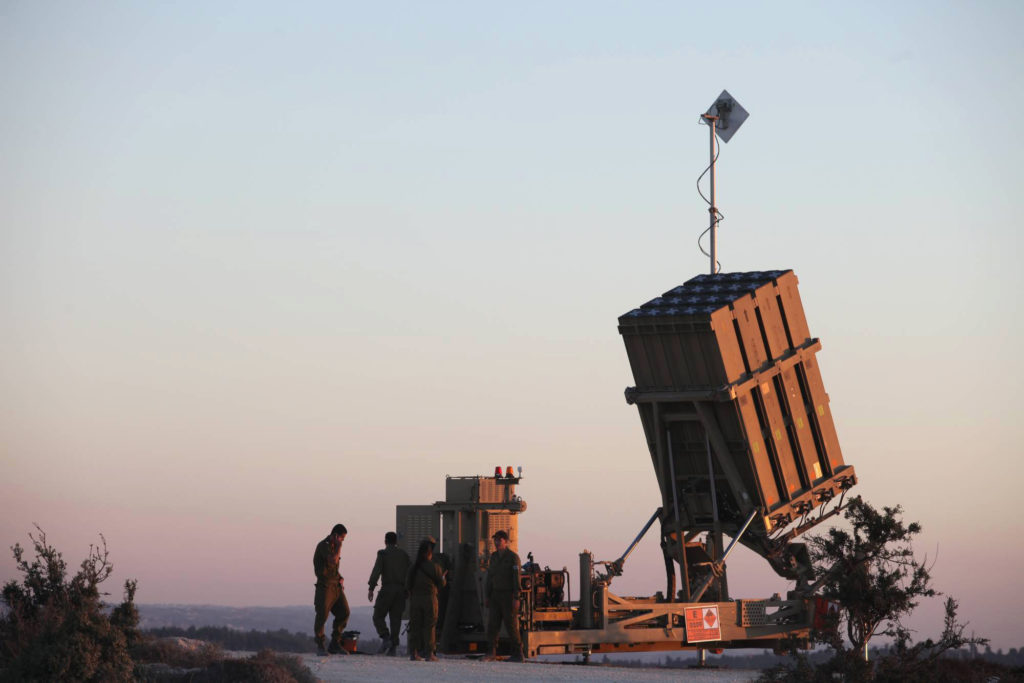Australia/Israel Review
Preparing for Hezbollah
Jun 2, 2021 | Lt. Gen. Richard Natonski and Jonathan Ruhe

With a ceasefire announced in Gaza, it’s crucial to apply the lessons learned to a likely future conflict with Hezbollah, and probably Iran, in Lebanon and beyond.
Hezbollah’s arsenals are an order of magnitude more potent than anything in Gaza, including at least 130,000 rockets and missiles that will do what Hamas conspicuously has yet to accomplish – namely, overpower Israel’s world-class multi-layered air defence network.
US President Joe Biden’s welcome decision on May 22 to replenish interceptor stocks for Israel’s short-range Iron Dome air defences – which were called upon more than ever in the latest flareup – is only a small glimpse of what Israel will need to defend itself in the next war.
In addition to Iron Dome, Washington must ensure adequate US-Israel co-production of David’s Sling and Arrow air defence systems that will be crucial for defending against Hezbollah’s and Iran’s much more sophisticated, powerful and longer-range projectiles, including precision munitions.
Since Hezbollah’s last war with Israel in 2006, Iran has assiduously rebuilt its primary terrorist proxy into a genuine juggernaut. Hezbollah now possesses more firepower than 95% of the world’s conventional militaries, and more rockets and missiles than all European NATO members combined.
As is the case with terrorist groups in Gaza, the vast majority of these are unguided short-range rockets.
Hezbollah also has thousands of more powerful unguided medium- and long-range rockets, many of them ranging all of Israel, compared to several hundred at most in Gaza that can reach central Israel. These longer ranges allow Hezbollah to disperse its arsenal throughout Lebanon, covering a much greater area than Gaza.
And unlike anything in the arsenals of Hamas or Palestinian Islamic Jihad, Hezbollah wields dozens or hundreds of precision missiles. Teheran also tries to proliferate technology to convert Hezbollah’s plentiful unguided rockets into precision weapons, and it assiduously attempts to make Syria, Iraq and Yemen into additional launchpads.
Because Iron Dome focuses on projectiles threatening built-up areas, Israel’s challenges will grow proportionally with the precision munition stocks of Iran, Hezbollah and other proxies around the region.
This encircling “ring of fire” from Lebanon and elsewhere could overwhelm Israel’s multi-layered air defences with barrages larger than anything yet seen. To be sure, Iron Dome held its own in recent Gaza conflicts. It did so even as the rate of incoming fire increased from 200 rockets daily in 2014 to as many as 400-500 per day in 2021, including 130-rocket barrages, and even as fully half of the recent rocket launches threatened populated areas (up from 20% in 2014).
But Hezbollah will launch as many as 3,000 rockets, missiles and drones daily at the outset of the next war – nearly as many as in the entire 2006 and 2014 wars – and then at a sustained rate of around 1,000 per day.
And finally, Hezbollah has gained valuable battlefield experience since its last war with Israel. It learned brutal combined-arms warfare in Syria, including in dense urban cauldrons like Aleppo, and now boasts advanced unmanned aerial vehicles, air defence, anti-tank, subterranean and other capabilities. Unlike Gaza terrorist groups, whose threats of cross-border incursions were minimal in the last conflict, Hezbollah will deploy these assets not just defensively, but also offensively in concerted ground invasions against northern Israel.
The ensuing conflict will greatly strain Israel’s Defence Forces (IDF) and population.
In all probability, the IDF would conduct an immediate combined-arms ground operation into Lebanon on a much larger scale than in 2006 or in Gaza in 2014.
With air defences shielding IDF installations, Israel’s critical infrastructure and cities will depend on passive defence measures and luck. Thousands of rockets and missiles will target industrial, electricity, water and transportation chokepoints, and Israel’s densely-populated coastal heartland. The result could be mass casualties, enormous physical destruction and severe disruptions to basic services.
Though damage to Israel likely will be unprecedented, this conflagration will resemble Gaza and Lebanon conflicts in one key respect. Like Hamas, Hezbollah illegally and intentionally puts civilians in harm’s way, emplacing its extensive military assets near and underneath apartments, schools, mosques and hospitals.
When IDF operations target these sites, Hezbollah will exploit the widespread misunderstanding of the law of armed conflict, disingenuously portraying Lebanese casualties and damage as the result of disproportionate and indiscriminate Israeli firepower – all while Hezbollah launches tens of thousands of unguided rockets indiscriminately at Israeli civilians.
Unlike with Gaza, the war’s sheer intensity will undermine continued IDF precautions, like “knock on the roof” and telephone warnings, that exceed the law of armed conflict’s requirements.
Like Hamas, Hezbollah will try to delegitimise Israel because it knows it cannot prevail militarily. As in 2006 and 2014, its adversaries will try to generate political and popular pressure on Israel to terminate legitimate operations prematurely.
Both before, but especially during, this incredibly intense large-scale war, US support for Israel’s freedom of action in legitimate self-defence against shared threats from Iran and its proxies will be more important than ever. This includes ensuring Israel has the necessary tools for its ongoing interdiction campaign against Teheran’s proliferation of precision missiles and other game-changing capabilities to Hezbollah and proxies in Syria, Iraq and elsewhere.
Because this next war will be fought in the court of public opinion as much as the battlefield, American leaders also should proactively educate media and international audiences – including the United Nations – on the law of armed conflict, the IDF’s adherence to it and its wilful distortion by Hezbollah, Hamas and US adversaries. This will be crucial to ensure ultimate Israeli success in a major conflict against shared Iranian threats, and to mitigate the appeal and effectiveness of similar strategies against legitimate US military operations in the future.






